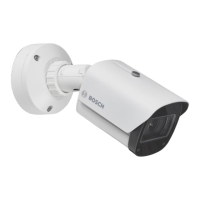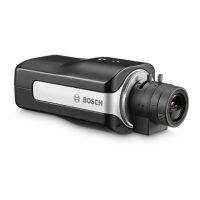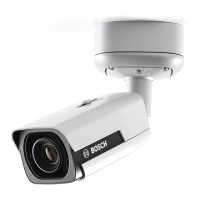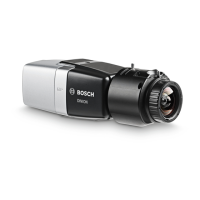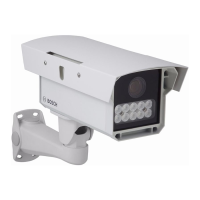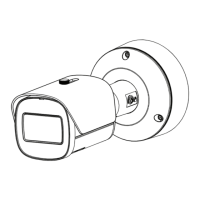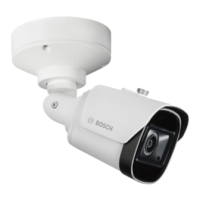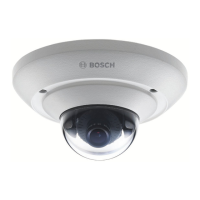Do you have a question about the Bosch DINION inteox 7100i IR and is the answer not in the manual?
Specifies the hardware and software requirements for using the web browser.
Details how to connect the camera to the network and access it via a web browser.
Explains the process of setting a strong password for camera access.
Describes the Live page for viewing the live video stream and controlling the unit.
Explains the Playback page for viewing recorded video sequences.
Details the Configuration page for setting up the unit and interface.
Describes the Dashboard page for detailed system information.
Details how to view live video streams, manage digital I/O, and check recording status.
Explains status icons for storage, CPU, and network load.
Describes various overlays providing status information like decoding errors and alarm flags.
Covers general identification settings for the device.
Details device name, ID, video name, host name, and initiator extension.
Explains password protection and different authorization levels.
Covers setting the device's date, time, and time zone.
Adapting the web interface and changing the website language.
Customizing the web interface appearance and language.
Selecting the language for the user interface.
Instructions for replacing the company logo in the interface.
Instructions for replacing the device logo in the interface.
Explains displaying VCA analysis results and object outlines.
Describes displaying object motion lines from VCA.
How to display overlay icons on the live video.
How to display VCA items like fields and lines.
How to enable the Dashboard feature.
How to secure cookies for camera access.
Customizing functions and controls displayed on the Live page.
How to transmit audio from the camera.
Setting the automatic logout time for the web interface.
Displaying alarm input status icons.
Displaying alarm output status icons.
Enabling the snapshot saving feature.
Managing network connectivity and cloud services.
Configuring communication with Bosch Remote Portal and partner services.
Defining accounts for FTP or Dropbox posting and recording export.
Setting up dynamic DNS for Internet access via host name.
Managing and installing user applications from the app store.
Steps for installing or managing user apps via Remote Portal or Configuration Manager.
Camera-specific settings and maintenance.
Accessing installer settings like sensor mode, image rotation, and reboot.
Global settings for stamping, camera name, and logo.
Adjusting font size and color for OSD messages.
Configuring the position and appearance of camera name overlays.
Uploading and positioning a logo on the image.
Displaying milliseconds in the time stamp.
Setting a custom message for alarm events.
Verifying video integrity using watermarking or digital signatures.
Setting camera perspective for video analytics by defining position parameters.
General description of mounting position and calibration parameters.
Setting the camera's vertical tilt angle for perspective.
Setting the camera's roll angle for perspective.
Specifying the camera's height from the ground plane.
Setting the camera's focal length for perspective.
Using manual drawing to calibrate camera perspective.
Selecting and defining coordinate systems (Cartesian or WGS 84).
Defining position using X, Y, Z axes.
Defining position using Latitude, Longitude.
Adjusting exposure, shutter time, gain, iris, day/night, zoom, focus, and white balance.
Configuring exposure mode, shutter time, and gain.
Selecting the mode for day or night vision.
Adjusting zoom position and focus.
Configuring automatic or manual white balance settings.
Configuring video stream profiles, resolution, and metadata.
Selecting streams for frame drop prevention.
Choosing the video coding standard (e.g., H.264, H.265).
Selecting predefined profiles for image quality or bit rate.
Selecting resolutions for streams not actively recording.
Enabling or disabling metadata display in streams.
Viewing bit rate information for scenes.
Defining regions to adjust encoding quality for specific areas.
Blocking specific areas of the scene from view.
Selecting color and configuring privacy mask areas.
Configuring audio gain, input volume, and recording format.
Selecting the audio recording format (e.g., AAC, G.711).
Enabling audio transmission and backchannel connection.
Using a tool to measure pixel counts in the image.
Information on recording images locally or to an iSCSI system.
Managing local microSD cards and iSCSI storage systems.
Selecting and configuring media for recording.
Setting up iSCSI connections for storage.
Using a microSD card for local recording.
Removing storage media from the managed list.
Formatting or wiping storage media for reuse.
Defining and assigning recording profiles for different times.
Selecting encoder profiles for stream recording.
Configuring what data (audio, metadata) is included in recordings.
Setting continuous recording mode.
Configuring pre-alarm recording.
Disabling automatic recording.
Selecting streams for standard recordings.
Setting pre-alarm and post-alarm times for alarm recordings.
Selecting streams for alarm recordings.
Configuring export of recordings to accounts.
Defining events that trigger alarm recordings.
Setting the duration for which recordings are kept.
Scheduling recording profiles for weekdays and holidays.
Assigning recording profiles to specific time periods on weekdays.
Defining holiday schedules that override weekly schedules.
Starting and stopping the recording schedule.
Displaying information about the current recording status.
Showing bit rate of recorded video, audio, and metadata.
Configuring saving of JPEG images to an FTP server.
Selecting how file names are created for posted images.
Enabling VCA overlays in posted JPEG images.
Setting the interval for sending JPEG images to an FTP server.
Selecting the account for JPEG posting.
Configuring alarm connections and event handling.
Setting up automatic connections to IP addresses upon alarm.
Enabling automatic connection when an alarm occurs.
Automatically re-establishing connections after disruptions.
Specifying the number of IP addresses to contact during an alarm.
Entering the IP addresses for remote alarm notification.
Setting passwords for remote alarm stations.
Selecting transfer protocols (TCP/UDP) for video transmission.
Selecting a browser port for network configuration.
Selecting analog video output for alarm images.
Selecting a decoder for split-image alarm display.
Protecting data with SSL encryption for secure connections.
Configuring integrated VCA for detecting and analyzing picture changes.
Generating alarms based on audio signals.
Enabling the device to generate audio alarms.
Assigning a unique name to identify audio alarms.
Excluding signal ranges to avoid false alarms.
Setting the threshold for signal detection.
Adapting sensitivity to the sound environment.
Configuring the camera to send e-mails for alarm events.
Enabling automatic sending of alarm e-mails.
Entering the IP address of the mail server.
Selecting the SMTP port for e-mail transmission.
Entering the user name for the mail server.
Entering the password for the mail server.
Selecting the data format for alarm messages.
Selecting the size of JPEG images sent with alarms.
Attaching JPEG images from specific video channels.
Including VCA overlays in alarm snapshots.
Entering the e-mail address for alarm notifications.
Defining the e-mail sender's name.
Testing the e-mail function for alarms.
Configuring alarm triggers and actions for inputs.
Setting the alarm trigger type (NC or NO).
Assigning a name to alarm inputs.
Selecting actions for alarm inputs (None, Monochrome, Switch mode).
Configuring output switching behavior for alarms.
Setting the output state when no alarm is active.
Defining how the output operates (e.g., Bistable, timed).
Selecting events that trigger outputs.
Assigning a name to alarm outputs.
Manually switching alarm outputs.
Editing alarm scripts for advanced automation.
Settings for integrating the device into a network.
Activating or deactivating available network services.
Configuring IP address, subnet mask, and gateway.
Enabling dynamic IP address assignment via DHCP.
Setting the IPv4 address for the camera.
Configuring the subnet mask for the IP address.
Setting the gateway address for remote connections.
Setting the IPv6 address for the camera.
Displays the automatically assigned IP address.
Setting the prefix length for the IP address.
Setting the gateway address for remote connections.
Entering DNS server IP addresses for easier access.
Selecting transfer protocols (TCP/UDP) for video transmission.
Enabling Adaptive Bit Rate encoding.
Setting the HTTP browser port, or disabling it.
Setting the HTTPS browser port for encrypted connections.
Selecting the minimum TLS version for security.
Enabling less secure HTTP basic authentication.
Using HTTP Strict Transport Security for secure connections.
Activating or deactivating RCP+ port 1756.
Setting maximum segment size for IP packets.
Specifying maximum package size for data transmission.
Advanced network settings.
Configuring RTSP port and function.
Configuring Radius server authentication.
Enabling Radius server authentication.
Entering the user name for Radius server authentication.
Entering the password for Radius server authentication.
Managing client and server certificates.
Configuring syslog server settings.
Managing network quality of service.
Configuring QoS for fast network response and predictable results.
Enabling multicast streaming for multiple receivers.
Enabling simultaneous data reception for multicast.
Setting a multicast IP address for data streams.
Setting the port address for multicast streams.
Activating multicast streaming mode.
Enabling multicast metadata.
Enabling multicast audio for encoders.
Setting the active time for multicast data packets.
Setting the IGMP version for multicast compliance.
Configuring filters for network traffic.
Entering IP addresses to allow or block network traffic.
Entering subnet masks for IPv4 filtering.
Service and maintenance operations.
Procedures for firmware updates and maintenance.
Checking connection to the update server.
Steps for updating the camera's firmware.
Viewing the history of firmware uploads.
Saving and loading device configuration data.
Downloading the device's maintenance log.
Managing software licenses and installation codes.
Adding, managing, and downloading security certificates.
Procedures for uploading or generating certificates.
Removing certificates from the device.
Downloading certificates from the device.
Configuring event logging, displayed entries, and software sealing.
Setting the level and number of log entries.
Enabling software protection against unauthorized access.
Retrieving detailed information of active logs.
Saving log entries to a computer.
Displaying system information for technical support.
Instructions for performing a hardware reset to factory defaults.
Legal notices regarding software and firmware usage.
Links to support services and training resources.
Accessing support services for various offerings.
Information on training courses and resources.
| Lens Mount | M12 |
|---|---|
| Infrared | Yes |
| Day/Night Functionality | Yes |
| Intelligent Video Analytics | Yes |
| Ingress Protection | IP66 |
| Impact Protection | IK10 |
| Sensor Type | CMOS |
| Lens Type | Varifocal |
| Wide Dynamic Range | 120 dB |
| IP Rating | IP66 |
| Power Supply (Alternate) | 12 VDC |
| Camera Type | IP Camera |
| Resolution | 4K Ultra HD |
| Video Compression | H.265, H.264, MJPEG |
| Operating Temperature | -30°C to +60°C |
| Power Supply | 12V DC, PoE |
| Image Sensor | 1/2.8" CMOS |
| Focal Length | Varifocal |
| IR Distance | Up to 30m |
| Power Consumption | 7.5W |
| Edge Storage | microSD card slot |
| ONVIF Compliance | Profile S, Profile G, Profile T |
| Resolution (Full HD) | 1920 x 1080 |
| IR Range | Up to 30m |
